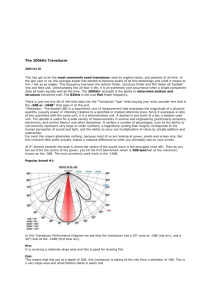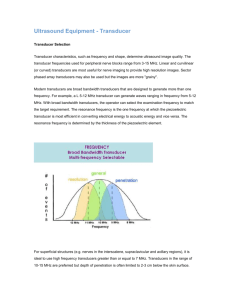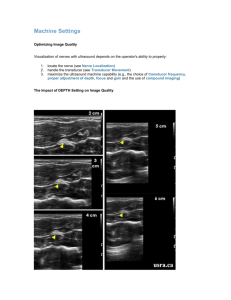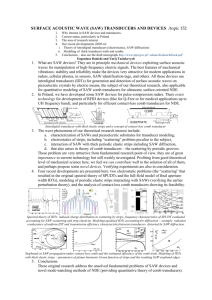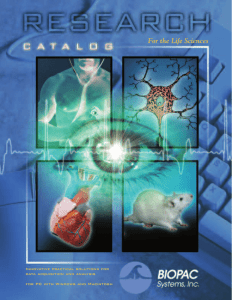Mechanical_Engineering_Laboratory_Equipment
advertisement
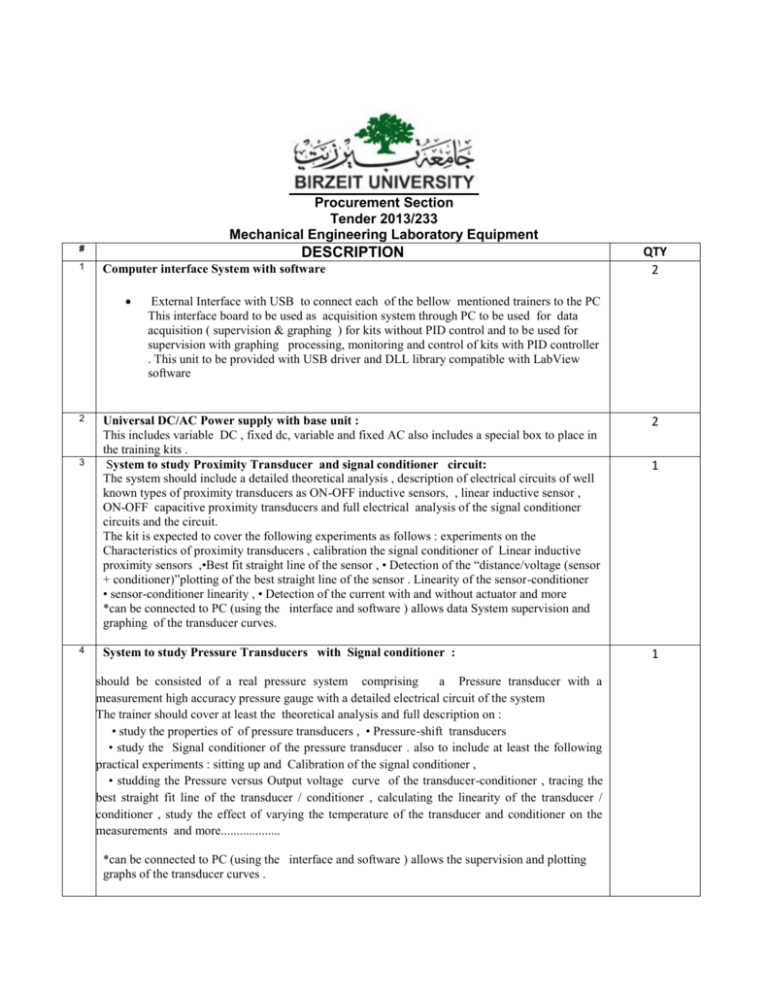
Procurement Section Tender 2013/233 Mechanical Engineering Laboratory Equipment # 1 DESCRIPTION Computer interface System with software 2 3 4 QTY 2 External Interface with USB to connect each of the bellow mentioned trainers to the PC This interface board to be used as acquisition system through PC to be used for data acquisition ( supervision & graphing ) for kits without PID control and to be used for supervision with graphing processing, monitoring and control of kits with PID controller . This unit to be provided with USB driver and DLL library compatible with LabView software Universal DC/AC Power supply with base unit : This includes variable DC , fixed dc, variable and fixed AC also includes a special box to place in the training kits . System to study Proximity Transducer and signal conditioner circuit: The system should include a detailed theoretical analysis , description of electrical circuits of well known types of proximity transducers as ON-OFF inductive sensors, , linear inductive sensor , ON-OFF capacitive proximity transducers and full electrical analysis of the signal conditioner circuits and the circuit. The kit is expected to cover the following experiments as follows : experiments on the Characteristics of proximity transducers , calibration the signal conditioner of Linear inductive proximity sensors ,•Best fit straight line of the sensor , • Detection of the “distance/voltage (sensor + conditioner)”plotting of the best straight line of the sensor . Linearity of the sensor-conditioner • sensor-conditioner linearity , • Detection of the current with and without actuator and more *can be connected to PC (using the interface and software ) allows data System supervision and graphing of the transducer curves. 2 System to study Pressure Transducers with Signal conditioner : 1 should be consisted of a real pressure system comprising a Pressure transducer with a measurement high accuracy pressure gauge with a detailed electrical circuit of the system The trainer should cover at least the theoretical analysis and full description on : • study the properties of of pressure transducers , • Pressure-shift transducers • study the Signal conditioner of the pressure transducer . also to include at least the following practical experiments : sitting up and Calibration of the signal conditioner , • studding the Pressure versus Output voltage curve of the transducer-conditioner , tracing the best straight fit line of the transducer / conditioner , calculating the linearity of the transducer / conditioner , study the effect of varying the temperature of the transducer and conditioner on the measurements and more................... *can be connected to PC (using the interface and software ) allows the supervision and plotting graphs of the transducer curves . 1 5 Practical Application Trainer for Pressure Control of a real system : The system should include a real pressure system that includes an Air compressor mounted on vibration damping base , compressor with air tank , • Proportional valve , • Piezoresistive transducer , • Indication pressure gauge , • Load variation device The main circuits of module SHOULD include : , • Set-point ,• Error amplifier • Signal conditioner of the transducer • PID controller • Power amplifier for proportional valve 1 The module enables the detailed theoretical analysis for • General characteristics of transducers , linearity of a transducer • Signal conditioners .The trainer should cover at least the following Practical experiments : 1) Calibrating the signal conditioner. 2) Calibrating the power amplifier. 3)calibrating the set-point. 4) Calibrating the PID controller and Error Amplifier block. 5) Measuring the characteristic curve of the pressure transducer. 6) Plotting the best fit line of the pressure transducer and checking its linearity. 7) Exercises in automatic pressure control with proportional action. 8) Automatic control using a PID controller 6 System to study Speed and Position transducers and control : the unit should include a DC permanent magnets motor , Potentiometer position transducer • Tachometric and optoelectronic speed transducers , Devices for load variation 1 The main control unit to include : Set-point , • Error amplifier • Signal conditioners for transducer , • PID control with independent actions • Armature current limit , • “H”-bridge DC/DC converter The module enables detailed theoretical analysis and or the experiments on the following main subjects: 1) Automatic open-loop speed control. of a dc permanent motor. 2) Automatic closed-loop speed control. 3) Closed-loop automatic speed control: Effect of the different components of the PID controller. 4) System step stress: variations on the PID controller constants. 5) Automatic position control 6) Angular position automatic control: Effect of the different components of the PID controller can be connected to PC (using the interface and software ) allows data acquisition, graphing editing and processing, monitoring and control of processes(PID) 7 System to Study PWM DC Motor Speed control : should include DC permanent magnet motor , Mechanical brake and control board The module should enable the theoretical analysis and the experiments on the following main subjects 1) Calibration of the PI controller 2) Calibration of the maximum current 3) Calibration of the speed detector 4) Measurement of the open loop speed of the dc motor 1 5) Measurement of the open loop current 6) Voltage duty-cycle speed curve of PWM regulator 7) Measurement of the closed loop speed 8) Measurement of the closed loop current 9) Variation of the speed regulator gain 10) Variation of the current regulator gain 11) Variation of the time constants of the regulation block can be connected to PC (using the interface and software ) allows the supervision and plotting graphs of the transducer curves . 8 System to Study Stepper motor : The system to include a real stepper motor system of 4 phases The module should enable the theoretical analysis and the experiments on the following main subjects: • Operating principles, terminology and technical characteristics of stepper motors , • Waveforms of the phase current , • Unipolar and bipolar driving • Full step operation , • Half step operation , • Single step and constant speed progress • Driving sequence creation , • Power circuits for phase driving can be connected to PC (using the interface and software ) allows the supervision and plotting graphs of the transducer curves . 1 9 Simulator for Control processes : This trainer should cover both linear and no-linear systems The main functional linear blocks present on this simulator are: • Set-point • Error amplifier • P-I-D regulator with independent actions • “LEAD” & “LAG” networks • Process The non-linear functional blocks present on the simulator , are: • Saturation , • Dead band , • Hysteresis This module should enable detailed theoretical analysis for : • Physical description , mathematical model • Linear systems: integral-differential equations , • Input-output ratios: transfer functions • Feedback systems , • Actions: - Proportional - Integral - Derivative , - Lead , - Lag The trainer to cover at least the following experiments : 1 1) Measurement of the exact value of the variable parameters in correspondence with the reference marks. 2) Analysis of the non linear unit. 3) ON-OF open-loop manual regulation. 4) Continuous open-loop manual regulation. 5) Automatic closed-loop proportional (p) regulation. 6) Automatic closed-loop proportional-integral regulation. 7) Setting the PID regulator using the Ziegler-Nichols procedure. 8) Setting the PID regulator the Janssen-Offereins procedure . 9) Setting the PID regulator according to the system indicial response. 10) The influence of “limits” on the regulation of a process not containing. 11) The influence of “limits” on the regulation of a process containing a pure integrator. 12) The influence of the “dead band” on the regulation of a process. 13) Auto closed-loop ON/OFF (two unidirectional states) regulation. 14) Automatic three-state regulation (bi-directional PWN). 15) The influence of linear hysteresis (backlash) on closed-loop regulation. 16) Analysis in the frequency domain of the characteristics of a closed-loop regulation system. 17) Analysis in the time domain of the characteristics of a closed-loop regulation system. 18) Verification of the design of a “led” type compensating network obtained by applying the 10 Nyquist theory. 19) Verification of the design of a “leg” type compensating network obtained by applying the theory of the root locus plot System to study Ultrasonic Sensors : This trainer should allow Student experiences on subjects related with ultrasonic transducers and the relative signal conditioning circuits in the context of the ultrasonic radar the system should cover detailed theoretical analysis of Piezoelectric materials: mechanical and electrical properties; • Characteristics of the ultrasonic sensors; • Signal Conditioning circuits; the system should has also the ability to carry at least the following practical experiments : • Generation and modulation of the transmitted signals; • Demodulation and conditioning of the received signals; • Comparation of the emitted and received signals; • Conversion of the signals for the interface; • Visualization; • Analysis of the obstacles reflectant characteristics; • Analysis and use of the supervision software with the Personal Computer 1

